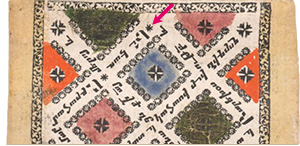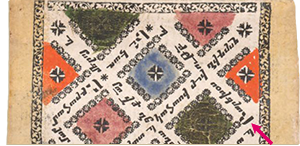Hmayil: Part 15
Հմայիլ. բաժին ԺԵ
The first text starts diagonally ↙ at the top:

and continues in the following parallel diagonal ↙ lines.
*Եւ էառ Աբրահամ զորդին իւր իսահակ և տարաւ ՚ի զենլիս իւր. և ասէ Իսահակ որդին ցհայրն: Հայր իմ ահա փայտ և ահա՛ հուր, ո՞ւր է ոչխար ողջակէզ. և ասէ աբրահամ ցորդին իւր իսահակ՝ որդեակ իմ աստուած տեսանէ ոչխար իւր ողջակէզ: յայնժամ առեալ զսուրն իւր և կամէր զենուլ զորդին իւր: և ահա՛ երևեցաւ հրեշտակ տեառն առ կաղնեաւն մամբրէի և ասէ՝ աբրահամ աբրահամ մի՛ մխեր զձեռն քո ՚ի պատանեակդ յայդ. և նոյն ժամայն տեսեալ ՚ի ծառոյն յայնմիկ կախեալ խոյ ողջակէզ յայնժամ առեալ զորդին իւր ուրախութեամբ օրհնէր զաստուած
The text continues from the last diagonal ↙ line, to the right-side column below:

և ասէր տէր երևեցաւ ՚ի տեղիս այսմիկ. և կոչեաց աբրահամ տեղին այն զի տէր երևեցաւ. և սառայ ետես զորդին իւր և ուրախ եղև յոյժ ուրախութեամբ մեծաւ: և սահակ ծերացեալ ալեօք ծաղկեցաւ և հանգեաւ խաղաղութեամբ ՚ի տէր: Բարեխօսութեամբ նահապետին հօրն մերում աբրահամու. և որդւոյ նորին իսահակայ Օգնեսցէ քրիստոս աստուած մեր առ ծառայս իւր (name) և Փրկեսցէ ամենայն չարեաց. և ամրածածուկ աջօվն իւրով պարսպեալ պահեսցէ անխռով մինչև ՚ի խորին ծերութիւնն. և ՚ի հանդերձելումն երկնից արքայութիւնն պարգևեսցէ ամէն:
And Abraham took his son Isaac and carried [him] away to his sacrifice. And Isaac the son said to the father, “My father, behold! the wood and behold! the fire. Where is the sheep for the burnt offering?” And Abraham said to his son Isaac, “My little son, God sees his sheep [for] the burnt offering.” Then, [Abraham] took his knife, and intended to sacrifice his son. And behold! an angel of the Lord appeared near the oak of Mambre, and said, “Abraham, Abraham, do not plunge your hand into this lad!” And [at] that same time, [Abraham] saw a ram [for] the burnt offering hanging on that tree, then [he] took his son with rejoicing [and] blessed God and said “the Lord appeared in this place.” And Abraham called the place “that [in] which the Lord appeared.” And Sarah saw her son and became very glad with great rejoicing. And Isaac, aged with white hair, flourished, and [finally] rested in peace in the Lord. Through the intercession of our father the patriarch Abraham, and of that same one’s son Isaac, let Christ our God give help to this servant of his (name), and let [Christ] save [him from] all evils. And fortified by his right hand encircling [this servant] as a rampart, let [Christ] keep [him] untroubled until his ripe old age. And in the world to come, let [Christ] bestow the kingdom of heaven [to this servant]. Amen.
The second text starts diagonally ↖ at the top:

and continues in the following parallel diagonal ↖ lines.
Բարեխօսութեամբ և Աստուածային սուրբ նշանացն քրիստոսի աստուծոյ մերոյ և անբարբառ բարեխօսացն վասն ազգի մարդկան սուրբ խաչքն ամենայն: նախ աւազակի սուրբ նշանի. վարագա սուրբ նշանի. պատերազմի սուրբ նշանի. երևման սուրբ նշանի. հաղբաթայ սուրբ նշանի վանկոյ սուրբ նըշանի. կաղբայ սուրբ նըշանի. արգինեայ սուրբ նշանի անիսերեխ սուրբ նշանի. մարառա սուրբ նշանի գանձասարա սուրբ նշանի: ջալէ թու թուխ մանուկին և քրիստոսի սուրբ գեղարդին. տէրունական սուրբ նշանի գռու սուրբ նշանի: գետարգել սուրբ նշանի. սքա
The text continues from the last diagonal ↖ line, to the left-side column below:

նչելագործ սուրբ նըշանի. ապարանից սուրբ նշանի. կարմըրակ սուրբ նշանի. ծիծռան սուրբ նշանի. աղթամարայ սուրբ նշանի. սահանու սուրբ նշանի. վարոսի սուրբ նշանի. կիրիոսի սուրբ նշանի. Կոստանդիանոսի սուրբ նշանի. տապանակի սուրբ նշանի. Վրաց և հոռոմոց սուրբ նշանի. կոստանդիանուպօլիս սուրբ նշանի. հապէշու և խփտոյ սուրբ նշանի. հացունեաց սուրբ նշանի. գայկըլայ սուրբ նշանի. խըրշտու սուրբ նշանի. մնդկու սուրբ նշանի կապնկայ սուրբ նշանի պիզեռու սուրբ նշանի. սիմայի սուրբ նշանի. բստու սուրբ նշանի. նսարի սուրբ նշանի Հրաշափառ սուրբ նշանին Քրիստոսի. որ ՚ի գալստեան յառաջագոյն գայ. և եկեալ կանգնի ՚ի գողգոդա՝ փայլելով եօթնպատիկ առաւել քան զարեգակն: Եւ այլ ամենայն սուրբ նշանացն՝ որք ընդ հանուր տիեզերս իցեն. սոցին սուրբ և արժանաւոր բարեխօսութեամբն՝ ողորմեա՛ համայն հաւատացելոցս. ՚ի քեզ՝ և ՚ի խաչ քո սուրբ: և Օգնական լեր ծառայիս քո (name) ամենայն ժամ. ամէն:
Through the intercession also of the Divine Holy Signs of Christ our God, and of the voiceless intercessors for the sake of the human race, all the Holy Crosses: the Holy Sign of the First Thief, the Holy Sign of Varag, the Holy Sign of War, the Holy Sign of the Apparition, the Holy Sign of Haghbat‘, the Holy Sign of Vanik, the Holy Sign of Gaghep, the Holy Sign of Argine, the Holy Sign of Aniserekh, the Holy Sign of Maraṙ, the Holy Sign of Gandzasar, the Jalēt‘ T‘ukh Manuk and the Holy Lance of Christ, the Dominical Holy Sign, the Holy Sign of Keṙ, the Getargel Holy Sign, the Miracle-Worker Holy Sign, the Holy Sign of Aparank‘, the Holy Sign of Karmrak, the Holy Sign of Tsitsṙan, the Holy Sign of Aght‘amar, the Holy Sign of Sahan, the Holy Sign of Varus, the Holy Sign of Cyrus, the Holy Sign of Constantine, the Holy Sign of the Ark, the Holy Sign of the Georgians and Romans, the Holy Sign of Constantinople, the Abyssinian and Coptic Holy Sign, the Holy Sign of Hats‘unik‘, the Holy Sign of Gaykil, the Holy Sign of Khrit, the Holy Sign of Mndik, the Holy Sign of Kapnik, the Holy Sign of Pizeṙ, the Holy Sign of Simay, the Holy Sign of Pest, the Holy Sign of Nsar. Miraculous Holy Sign of Christ, which arrives at the first coming [of Christ], and comes and rises up at Golgotha, shining seven times brighter than the sun. And all the other Holy Signs, which are throughout the entire universe, through the intercession of these same ones, have mercy on all these who believe in you and in your Holy Cross. And be helper to this servant of yours (name) all the time. Amen.
The foregoing translation is from Matthew J. Sarkisian. An Early-Eighteenth-Century Hmayil (Armenian Prayer Scroll): Introduction, Facsimile, Transcription and Annotated Translation, Edited and with a Foreword by Jesse S. Arlen. Sources from the Armenian Christian Tradition, volume 1. New York, NY: Krikor and Clara Zohrab Information Center, 2022. Used with permission.

